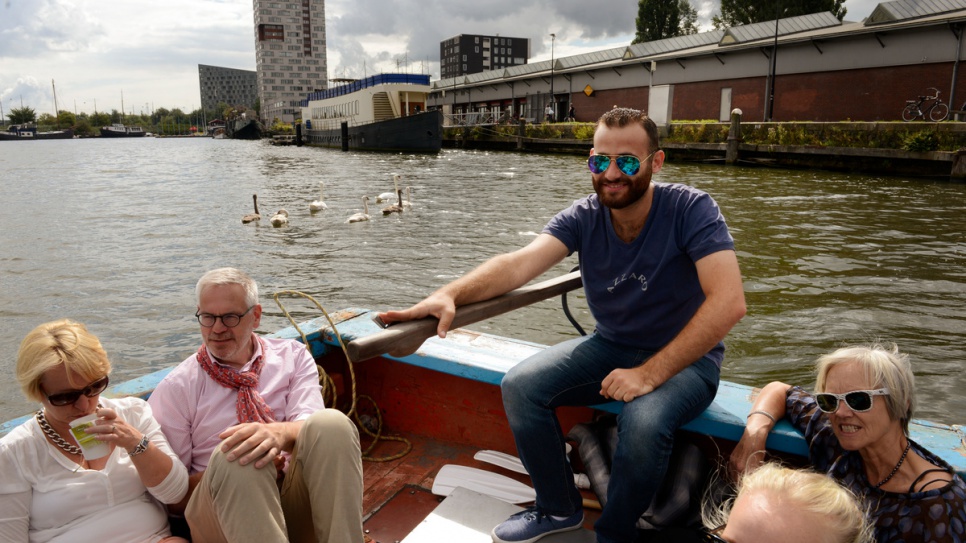Boat tours highlight Amsterdam’s refugee past
Tours on vessels once used to smuggle people across the Mediterranean spotlight city’s long history of welcoming refugees and migrants.
People board a boat for a tour of the canal network in Amsterdam through the eyes of refugees and migrants.
© UNHCR/Chris de Bode
© UNHCR/Chris de Bode
Two years ago, a small, mastless Egyptian fishing boat with peeling blue paint pushed off from the Tunisian coast with 76 people on board. Eighteen miles southwest of Sicily, on August 29 2014, it was found by the Italian coastguard and towed to land.
Today the Hadir and another vessel ply the more tranquil waters of Amsterdam’s canals, taking residents and tourists on tours of the city’s history as seen through the eyes of the refugees and migrants – famous, infamous and unknown – that helped shape the Netherlands’ largest city.
At its helm on the weekly tours – for which Amsterdam city authorities have limited numbers to 12 – are a varied group of skippers with one thing in common: they are all refugees who have reached Amsterdam in similar circumstances to the boats they sail.
“It took some convincing to get me back on a boat,” said one, Mohammed al-Masri, a 24-year-old Syrian refugee who reached Amsterdam in 2015.
He left Syria in 2012 with his parents, two sisters and a younger brother. They went first to Lebanon and then Jordan. There he found himself unable to care for his family.
Being asked to skipper Hadir, however, brought back memories of a journey on which he was smuggled across Turkey before being bundled on to a dinghy with dozens of others, including 11 children and one blind man, that took them to Greece. It was a frightening experience.
The opportunity to tell his story on the Hadir tours proved too tempting.
The Hadir and its sister vessel, both previously used to smuggle people across the Mediterranean. As well as the tours, they offer on-board dinners at which passengers are invited to meet and talk to refugees and immigrants, and shuttle transport to some of the city’s many festivals.
“I hope travelling with our crew will challenge these preconceptions.”The project, which is partly funded by the Dutch government, is the brainchild of Teun Castelein, a Dutch artist who in 2012 was disturbed by the way the media covered the plight of refugees and migrants who drowned making the hazardous crossing to Europe from North Africa.
He continues to be driven by a sense that public misconceptions about refugees and migrants need to be challenged, particularly the mischaracterization of refugees as either a potential threat or victims. “I think they are both misconceptions and I hope travelling with our crew will challenge these preconceptions.”
The project employs 10 people. All are refugees or migrants - some of them second generation – drawing on the city’s long history of welcoming immigrants and refugees through the ages.

Eritrean
Sami Tsegaye, 22, is one of the tour boat skippers. He reached the
Netherlands after crossing the Mediterranean Sea from Libya on vessel
similar to the one he now operates. “The first time on this boat was a
bit scary. After sailing so many times I’m much more relaxed now. I
learned to swim. I love it.” © UNHCR/Chris de Bode
It subsequently became a magnet for persecuted minorities from throughout Europe over the next century: Protestant bankers from Belgium, wealthy Jews escaping the Inquisition in Spain and Portugal, poorer Jews from Eastern Europe, Huguenots from France. By the middle of the 17th century it was the continent’s most important commercial hub.
Today, the city is home to people of 180 different nationalities. About 45 per cent of the greater metropolitan population of 1.6 million are from an ethnic minority.
“They are humans just like you, they have minds, they can think, they can fill some spaces and improve some things.”The tour highlights the experience of refugees and migrants through history. There was the executed Danish girl, Elsje Christians, garrotted for murder and her body exhibited as a warning to others. Her remains were drawn by Rembrandt while they were on public display.

Rederij
Lampedusa owns two boats. A small one named “Hedir” (Stormy Weather)
and a bigger one named “Al Hadj Juma” (Mister Friday). © UNHCR/Chris de
Bode
Masri says his role on the tour complements that history.
“I am a real fact,” he said. “I am a fresh story. I hope it raises awareness that newcomers are not just here to steal your money or corrupt your country. They are humans just like you, they have minds, they can think, they can fill some spaces and improve some things.”
Passenger Piet van den Boog, sailing on the Hadir for the first time, said the opportunity to meet refugees was important because direct contact between people was always the most effective.
Besides, the 64-year-old painter added, “the boat tells its own story.”


No comments:
Post a Comment